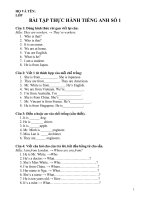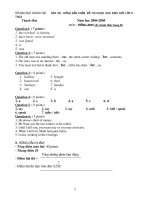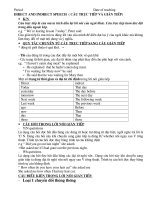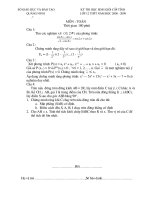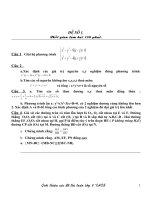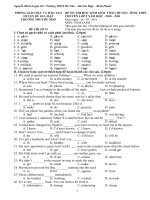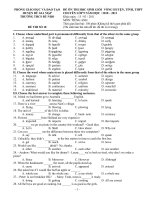Ôn thi HSG (có đáp án)
Bạn đang xem bản rút gọn của tài liệu. Xem và tải ngay bản đầy đủ của tài liệu tại đây (79.04 KB, 11 trang )
LEXICO-GRAMMAR
1. It is high time we canceled our marketing campaign as it hasn’t helped to _____ in sales for months.
A move the needle
B beat the drum
C tip the scales
D change tack
2. I'm not surprised that Tina showed up with purple hair today—she loves _____ with her hair color.
A kicking the bucket
B getting the ball rolling
C drawing straws
D ringing the changes
3. I think I will _____, it is unacceptable for a student to hold a racist attitude towards his teacher.
A tell him a thing or two
B pick his moment
C tick off on his fingers
D get his brain in gear
4. He is a careful guy who will always get his _____ in a row before he starts doing anything.
A dogs
B chickens
C ducks
D kids
5. After the seventh time Ally came late to work, the teacher lost her patient and hauled him over _____.
A the fire
B woods
C boiling water
D the coals
6. The green protest is expected to _____ steam after the minister allows the construction of a shopping
center in place of the park.
A pick up
B take up
C carve up
D clock up
7. It is hard to understand what led to a prejudicial attitude and _____ hatred of women in a person
brought up in a progressive family like him.
A foul
B obnoxious
C pathological
D innocuous
8. With a record of 22000 flying hours, Callaghan proved to be an _____ and shrewd pilot for these storms.
A inimitable
B imperturbable
C impermeable
D unshakeable
9. In this story, the criminal is depicted as a person with a genius mind and a _____ pleasure in watching
others suffer.
A ascetic
B dexterous
C stoic
D perverted
10. The view from the top of Lang Biang was so breathtaking that we just stood there _____ the scenery.
A bristling up in
B breaking in
C drilling in
D drinking in
11. I think you had better spend some time to _____ certain factors before applying for that position, the
deadline is still far away
A mull over
B bowl over
C sleep over
D boil over
12. Recent inconsiderate statements Mr. Key made in the public are believed to be _____ to the
cooperation between our company and the DYC.
A innocuous
B prejudicial
C vacuous
D sinister
13. As coincidental as the first time they met each other, that actually was also part of her scheme to _____
this rich guy.
A snarf
B snark
C snarl
D snare
14. As a public figure, whose life and behavior are the focus of intense public interest, I have gradually
become _____ to criticism and scrutiny.
A impermeable
B impertinent
C impervious
D imperious
15. My aunt is clearly bathing in the reflected _____ of her son’s outstanding performance and enviable
achievements in the National Contest.
A glow
B glory
C fame
D splendor
Word form
1. The second time the player was shown the yellow card for his _____unsporting____ actions during the
game, he was dismissed from the field. (SPORT)
2. The prevalence of illegal drug ____trafficking____ in the Philippines is lower than the global average,
partly thanks to strict drug policies in this country. (TRAFFIC)
3. I think hibiscus will do poorly as a ____houseplant_____, given the fact that it is native to tropical regions
and adores full sun. (PLANT)
4. Imported coffee is having a difficult time trying to find a ____foothold____ in the Vietnamese market
Vietnam. (FOOT)
5. I don’t have the _____willpower____ to stay on a diet so the only way for me to lose weight is exercising.
(POWER)
READING
Part 1. For questions 1-13, read the following passage and do the tasks that follow.
EATS, SHOOTS AND LEAVES
a book review
The title of Eats, Shoots and Leaves refers to a famously misplaced comma in a wildlife manual that ended
up suggesting a panda rather violently “eats, shoots and leaves” instead of eating shoots and leaves. The
author of this book, journalist Lynne Truss, is something akin to a militant linguist, dedicating this “zero
tolerance” manifesto on grammar to the striking Bolshevik printers of St. Petersburg who, in demanding
the same remuneration for punctuation as they received for letters, ended up setting in motion the first
Russian Revolution.
Some of the book involves humorous attacks on erroneous punctuation. There is the confused
Shakespearian thespian who inadvertently turns a frantic plea: “Go, get him surgeons!” into the cheerful
encouragement of “Go get him, surgeons!” Street and shop signs have a ubiquitous presence. A bakery
declares “FRESH DONUT’S SOLD HERE” and a florist curiously announces that “Pansy’s here!” (Is she?).
The shameless title of a Hollywood film Two Weeks Notice is reeled in for criticism—“Would they
similarly call it One Weeks Notice?” Truss enquire—and sometimes, as in the case of signs promoting
“ANTIQUE’S” and “Potatoe’s”—one questions whether we are bearing witness to new depths of grammar
ignorance, or a postmodern caricature of atrocious punctuation.
Eats, Shoots and Leaves is not just a piece of comedy and ridicule, however, and Truss has plenty to offer
on the question of grammar usage. If you have ever wondered whether it is acceptable to simply use an
“em dash” in place of a comma—the verdict from Truss is that you can. “The dash is less formal than the
semicolon, which makes it more attractive”, she suggests. “It enhances conversational tone; and it is
capable of quite subtle effects.” The author concludes, with characteristic wry condescension, that the em
dash’s popularity largely rests on people knowing it is almost impossible to use incorrectly. Truss is a
personal champion of the semicolon, a historically contentious punctuation mark elsewhere maligned by
novelist Kurt Vonnegut Jr., as a “transvestite hermaphrodite representing absolutely nothing”. Coming to
the semicolon’s defense, Truss suggests that, while it can certainly be over-used—she refers to the dying
words of one 20th century writer: “I should have used fewer semicolons” —the semicolon can perform
the role of “a kind of Special Policeman in the event of comma fights.”
Truss has come under criticism on two broad points. The first argument criticizes the legitimacy of her
authority as a punctuation autocrat. Louis Menand, writing in the New Yorker, details Eats, Shoots and
Leaves' numerous grammatical and punctuation sins: a comma-free non-restrictive clause; a superfluous
ellipsis; a misplaced apostrophe; a misused parenthesis; two misused semicolons; an erroneous hyphen
in the word “abuzz", and so on. In fact, as Menand notes, half the semicolons in the Truss book are
spuriously deployed because they stem from the author’s open flouting of the rule that semicolons must
only connect two independent clauses. “Why would a person not just vague about the rules but
disinclined to follow them bother to produce a guide to punctuation?" Menand inquires. Ultimately, he
holds Truss accused of producing a book that pleases those who “just need to vent'' and concludes that
Eats, Shoots and Leaves is actually a tirade against the decline of language and print that disguises itself,
thinly and poorly, as some kind of a style manual.
Linguist David Chrystal has criticized what he describes as a “linguistic purism" coursing through Truss’
book. Linguistic purism is the notion that one variety of language is somehow more pure than others,
with this sense of purity often based on an idealized historical point in the language’s development, but
sometimes simply in reference to an abstract ideal. In The Fight for English. How Language Pundits Ate,
Shot and Left, Chrystal —a former colleague of Truss—condemns the no-holds-barred approach to
punctuation and grammar. “Zero tolerance does not allow for flexibility," he argues . “It is prescriptivism
taken to extremes. It suggests that language is in a state where all the rules are established with 100 per
cent certainty. The suggestion is false. We do not know what all the rules of punctuation are. And no rule
of punctuation is followed by all of the people all of the time."
Other detractors of Truss’ “prescriptivism" are careful to disassociate needless purism from robust and
sensible criticism, an oppositional stance they call descriptivism. “Don’t ever imagine," Geoffrey K. Pullum
on the Language Log emphasizes, “that I think all honest attempts at using English are just as good as any
others. [Bad] writing needs to be fixed. But let’s make sure we fix the right things." In other words, we do
not require a dogmatic approach to clean up misused language. Charles Gaulke concurs, noting that his
opposition to “prescriptivism" does not require contending with the existence of standards themselves,
but questioning whether our standards should determine what works, or whether what works should
determine our standards.
Ultimately, it is unlikely the purists and pedagogues will ever make absolute peace with those who see
language as a fluid, creative process within which everyone has a role to play. Both sides can learn to live
in a sort of contentious harmony, however. Creativity typically involves extending, adapting and
critiquing the status quo, and revising and reviving old traditions while constructing new ones. Rules
must exist in order for this process to take place, if only for them to be broken. On the flip side, rules have
an important role to play in guiding our language into forms that can be accessed by people across all
manner of differences, so it is vital to acknowledge the extent to which they can be democratic, rather
than merely autocratic in function. Nevertheless, all the regulations in the world cannot stem the natural
spring of language, which bursts through rivets and snakes around the dams that linguistic authorities
may try to put in place. We should celebrate rather than curse these inevitable tensions.
Questions 1-6
In boxes 1-6, write:
True
if the statement agrees with the information
False
if the statement contradicts the information
Not Given
if there is no information on this
1. A well-known error lays the groundwork for Truss’s book.
2. Humour is utilized to aid the delivery of subliminal messages in the book.
3. Truss’s view of punctuation marks diverges from that of another writer.
4. According to an adversary, the book fails to serve its stated role.
5. Mutability in the rule of punctuation is accepted when zero tolerance is applied.
6. The development of language is fundamentally unstoppable.
Your answers
1. T
2. NG
3. T
4. T
5. F
6. T
For questions 7-13, complete the following paragraph with words taken from the passage.
The review gives readers an insight into a book on grammar and punctuation by Lynne Truss which was
dedicated to people who ignited the first Russian Revolution with their request for (7)
______remuneration for punctuation______. Included in the book is criticism heaped upon incorrect
punctuation, with the repeated appearance of (8) _______semicolons_________. Some cases involving such
anomalous use can even be considered a(n) (9) _______kind of Special Policeman in the event of
comma fights______. Beside certain merits, the book has also come under fire. One of the arguments
against it describes Truss as (10) _____a punctuation autocrat______ and highlights grammatical mistakes
in her book. It has also been castigated due to a sense of (11) _______a style manual_______ conveyed.
Furthermore, Truss’s perspective, described as prescriptivism, has met with disapproval from people
who oppose the use of (12) ______descriptivism______ to rectify linguistic errors. This oppositional stance
and prescriptivism are stated to be constantly at loggerheads, but they can still co-exist in such a state of
(13) ______contentious harmony_______.
Part 2. For questions 14-23, read an extract from an article and choose the answer A, B, C or D that
fits best according to the text. Write your answers in the corresponding numbered boxes
provided.
WHY DO WE KEEP PETS?
Why do we keep pets? After all, we are surely the only species on the planet inclined to do so. Even our
closet cousins, the great apes, do not similarly indulge. Indeed, when footage of four chimps ‘playing’ with
an antelope recently emerged, it caused much debate on the subject momentarily until the exact
circumstances of the ‘play date’ were understood. The chimps at first played innocently with the calf, then
gradually their play became rougher and rougher and sadly, the calf did not come out the other end of the
game alive. Despite this, the chimps continued to amuse themselves with the corpse with no less
enthusiasm for a further half hour. Now, do you see?
Humans, contrarily invest heavily on an emotional and financial level in their domestic animals, and this
again begs the question: why exactly? After all, there is no conclusive evidence to suggest that we benefit
health-wise from, for instance, increased longevity by keeping them and the effort of caring for pets
definitely outweighs any payback there is. As mentioned, pets are high-maintenance and require meals,
healthcare and housing, and, though they provide companionship for some and practical services like
guarding for others, caring for them is extremely time-consuming. They often require walking, grooming,
worming and much else besides. Yet in spite of all this, for many, they are an intrinsic part of the family,
almost like having a child around.
However, the comparisons end before they even begin in that respect. After all, there are practical
reasons for having children. From an evolutionary perspective, they keep the genes alive. Not to mention
the fact that they can return the favor of care years down the line when you have grown old and they are
in the prime of their existence. And whilst they also demand an enormous amount of care and attention
(admittedly, there are similarities in some respects, then!), they can and are typically expected to
contribute actively to family affairs themselves as they get older. There is, in short, a clear return on
investment where kids are concerned.
[ ]. On the other hand, in the past, perhaps a practical agenda for keeping pets could not be ruled out so
summarily. [ ] For instance, pet-tending arguably may have demonstrated desirable female qualities in
the care-giver, making the carer more attractive to potential suitors. [ ] Indeed, the urge to care also
highlighted other admirable traits of a more empathetic nature. [ ]
Indeed, even today, some researchers argue the merits of pet ownership from a practical point of view,
suggesting that they might be helpful to humans lacking emotion and social support. The science, at least
in one respect, is clear and such people are definitely more vulnerable to disease and infection. However,
when it comes to the question of whether pets can adequately fulfil the vacant role, substituting for
human interaction, the situation is a lot more cloudy and contradictory research exists, with opinions
often toing and froing.
Besides, many of us are more like the chimps than we’d perhaps care to admit. For instance, the notion of
pet keeping is a cultural one which does not exist across all cultures. Some Kenyan indigenous tribes, for
instance, do not have a word for pet. They keep dogs, yet, but solely for their own protection. Indeed, in
some cultures young-dog meat itself is a staple of the traditional diet. Many Westerners claim this shocks
them and damn such behavior, but they will happily eat young sheep, with lamb being a favorite dish for
many. What’s the difference? You see, it’s all about perspective.
Some researchers suggest that pet keeping is a purely cultural phenomenon akin to fashion, indeed. In
other words, it is socially contagious and we keep pets because our friends and neighbors do – and there
is much evidence to support this assertion, in fact. However, the problem with this theory is it’s a bit like
that of the Big Bang, just as we can’t account for where the particles which produced same to create the
universe came from, nor can we explain how or why the perpetually self-reinforcing trend of petkeeping began.
14.Why does the writer use the example of the chimps in paragraph one?
A. to give an instance about the contrast between toys and pets
B. to demonstrate similar behavioral patterns between chimps and humans
C. to exemplify how evolved chimps have become
D. to prove that the subject remains a hotly debated manner
15.The writer implies that
A. keeping pets is not as altruistic as having children.
B. having children and pets are basically the same.
C. it would be more reasonable to have children than keep pets.
D. child bearing ought to take precedence over pet keeping.
16.According to the writer, the rationale behind pet ownership in the past may have been
A. people’s aspiration to appear sympathetic.
B. a yearning by members of one gender to show their compatibility as parents.
C. a craving for the generation of more weath and improvement of social status.
D. a need for an additional care-giver in the family.
17.In paragraph five, the writer suggests that
A. it has yet to be confirmed whether or not pets have beneficial impacts on the health conditions of
socially isolated people.
B. most researchers concur in relation to the practical benefits of having pets today.
C. research indicates pet owners are more susceptible to disease and infection.
D. pets can substitute the roles of humans in a social context for lonely individuals.
18.What does the writer mean when he mentions ‘perspective’ in the sixth paragraph?
A. Dogs are blatantly abused in certain cultures.
B. Dogs can fulfil the dual role of protector and pet.
C. We cannot judge others by our own conventions.
D. Several countries exploit dogs solely for hunting purposes.
19.Why does the author refer to Big Bang Theory?
A. To suggest that theories fall in and out of popularity within the scientific community.
B. To disprove the notion that pet keeping is fashion led.
C. To call for the implementation of a scientific approach to examine pet keeping habits.
D. To insinuate that a certain theory about pet keeping habits is flawed.
20.The word “antelope” in paragraph 1 mostly means
A. a favorite toy of chimps.
B. chimps’ companion.
C. a corpse that chimps play with.
D. a large mammal like a deer.
21. Look at the four squares [ ] that indicate where the following sentence could be added to the
passage.
Alternatively, pet-keeping may have served as a symbol of status and wealth; after all, before you
can own one, you must sound finances.
Where would the sentence best fit?
A. First square.
B. Second square.
C. Third square.
D. Fourth square.
22.Why does the author mention Big Bang in the final paragraph?
A. To highlight the role of the Big Bang theory.
B. To identify a stark contrast between the origin of the universe and that of the pet keeping habit.
C. To account for the origin of the pet keeping trend.
D. To illustrate the ambiguity in finding out the root of the pet keeping trend.
23.The phrase “perpetually self-reinforcing trend” in the final paragraph mostly means
A. a tendency that has reinforced pet keeping habits so far.
B. a trend that has existed for a long time.
C. a trend that serves to strengthen itself for a long time.
D. a tendency that aims to perpetually keep pets.
Your answers
14.
15.
16.
17.
18.
19.
20.
21.
22.
23.
Part 3. In the passage below, seven paragraphs have been removed. For questions 24-30, read the
passage and choose from the paragraphs A-H the one which fits each gap. There is ONE extra
paragraph which you do not need to use. Write your answers in the corresponding numbered box
provided.
VALUES FOR A GODLESS AGE
When the Berlin Wall came tumbling down in 1989 so did the plaster cast which had kept the idea of
human rights in limbo. It was now free to evolve in response to the changing conditions of the late
twentieth century.
24.
E
Of course, in one sense, the quest for universal human rights standards after the Second World War was
an early attempt to communicate across national boundaries, albeit a rather faltering endeavour, with its
claims to universality challenged both in terms of authorship and content. More recently, a loosening of
the reins of the human rights dialogue has ushered in wider debate.
25.
F
Perhaps the best known of these is Amnesty International, established in 1961. Before Amnesty, there
were very few organizations like it, yet now there are thousands operating all over the world. Whether
campaigning for the protection of the environment or third-world debt relief, any such organization is
engaged in the debate about fundamental human rights. And it is no longer just a soft sideshow.
26.
B
The fact that strangers from different countries can communicate with each other through the worldwide
web is having a similar effect in dealing a blow to misinformation. During one recent major human rights
trial over sixty websites sprang up to cover the proceedings, while sales of the government-controlled
newspaper in that country plummeted.
27.
H
The effect of increased responsibility at this highest level has been to continually extend the
consideration of who is legally liable, directly or indirectly, under international human rights law. In part,
this is an acknowledgement that even individuals need to be held responsible for flagrant breaches of
others ‘rights, whether these are preventing protesters from peacefully demonstrating or abusing the
rights of children.
28..
D
It has been noted that paradoxically, in such circumstances, it may be in the interests of human rights
organizations to seek to reinforce the legitimacy and authority of the state, within a regulated global
framework.
29.
A
Part of the new trend in human rights thinking is therefore to include powerful private bodies within its
remit. The International Commission of Jurists has recently explored ways in which international human
rights standards could be directly applied to transnational corporations.
30.
G
Whatever the way ahead, the lessons of the past must be learnt. Any world view or set of values which is
presented as self-evident is ultimately doomed to failure. The case for human rights always needs to be
made and remade. In a world where globalization too often seems like a modernized version of oldfashioned cultural imperialism, it is important to query the claim that human rights are universally
accepted.
The missing paragraphs:
A. The problem is that the growth of globalization makes the protection of nation states a pointless goal
in certain circumstances. Transnational corporations with multiple subsidiaries operating in a number of
countries simultaneously wield significant economic and political power and it is often extremely difficult
for the state - both home and host governments - to exercise effective legal control over them.
B. If the proliferation of pressure groups has raised the profile of the human rights debate, satellite
television has reinforced much of the content of their campaigns. The fact that from our armchairs we can
all see live what is happening to others around the world has had an enormous impact on the way the
struggle for human rights is viewed. It would not be remotely believable to plead ignorance nowadays,
for 24-hour news coverage from the world's hotspots reaches us all.
C. This is, after all, a uniquely propitious time, as the values and language of human rights are becoming
familiar to more and more people, who judge the merits or otherwise of political and economic decisions
increasingly in human rights terms. Arguments seem fresh and appealing in many quarters where once
they sounded weak and stale.
D. On a global scale, it is not strong states that are the problem here but weak ones, as they fail to protect
their citizens from private power - whether it is paramilitaries committing murder and torture or
transnational corporations spreading contamination and pollution.
E. One of the most significant of these is what has come to be called 'globalization', the collapsing of
national boundaries in economic, political and cultural life. From the expanding role of the world's
financial markets and the spread of transnational corporations to the revolution in communications and
information technology, more and more areas of people's lives are affected by regional, international or
transnational developments, whether they are aware of this or not.
F. Not only must states not infringe rights, and enforce those rights which fall within their direct sphere
(like providing a criminal justice system or holding fair elections), but they also have 'positive
obligations' to uphold rights enshrined in human rights treaties, even when it is private parties which
have violated them.
G. The results of its investigations were published in 1999 in a unique pamphlet on Globalization,
Human Rights and the Rule of Law. The issue to be faced is whether to treat these and other
corporations as 'large para-state entities to be held accountable under the same sort of regime as states',
or whether to look for different approaches to accountability 'that are promulgated by consumer groups
and the corporations themselves.'
H. No longer the preserve of representatives of nation states meeting under the auspices of the United
Nations, a developing conversation is taking place on a global scale and involving a growing cast of people
- for an increasing range of pressure groups now frame their aspirations in human rights terms.
Your answers
24.
25.
26.
27.
28.
29.
30.
Part 4. The passage below consists of four sections marked A, B, C and D. For questions 31-40,
read the passage and do the task that follows. Write your answers (A, B, C or D) in the
corresponding numbered boxes provided.
A NIGHT TO REMEMBER
Our reporter spent a night camping out inside a zoo in Australia
A. Scanning the breakfast menu, I found myself swiftly losing my appetite: on offer were beetle larvae,
maggots and frozen mice. Fortunately, spending the night at Sydney’s Taronga Zoo needn’t involve
sampling the animals’ meals, though it does entail getting extremely close to all manner of creatures. The
Roar and Snore programme, curiously little known in Australia let alone overseas, allows you to spend a
night camping in the heart of the zoo, long after the crowds of day trippers have dispersed. And if your
experience of zoos is creatures slumped motionless in their enclosures, or skulking in their dens, then let
me assure you that at dusk, the place comes alive and echoes with the din of hundreds of creatures
making their presence known. A ferryboat dropped me off at the foot of the zoo, which sprawls across a
steeply sloping swathe of bushland across the bay from the city. Guides, Steve and Nikki, awaited with
bright, enthusiastic smiles. Ten of us had signed up and, in no time at all, we were busily erecting tents on
a rectangle of grass outside the zoo’s education centre. An adjacent area of gum trees was inhabited by
kangaroos, wallabies and an alarmingly inquisitive emu – our first animal encounter.
B. After a quick briefing, we set off into the gathering gloom. Steve unlocked a huge metal gate that then
clanged ominously behind us. We were in, though not without some trepidation – what had we let
ourselves in for? It was just us, a handful of security staff and 2,000 furred and feathered inmates. A
gibbon let out a haunting, liquid whoop and wild possums frolicked noisily through the eucalyptus trees
above us, their dark silhouettes framed against a full moon. The skyscrapers of the city centre twinkled in
the distance as a pair of zebras scuffled in a cloud of dust; farther along, a giant Kodiak bear lumbered
menacingly around a large, rock-strewn enclosure. An awesome spectacle in the gloom, but the buzz that
evoked was soon surpassed when a pair of snow leopards came within a few feet of us as they paced
around the rocky ledges of their cage.
C. Not all the animals at Taronga are behind bars. Semi-tame African guinea fowl nest in the gum trees
and a water buffalo let out a surprisingly cow-like moo, whilst a group of macaws screeched as we
climbed back up to the education centre. It gets chilly after dusk, but Steve had left nothing to chance and
a warming barbecue was already sizzling with sausages and chicken kebabs. Meanwhile, Nikki brought
out some animals that are used to being handled: first a diamond python called Little Spots and then a
koala. Even the Australians in the group were enthralled as Nikki showed us the pad of hardened skin
that enables the species to sit for hours at a time in the crook of a tree. As she explained, the gum trees
they eat contain only four percent protein, so they have little energy to do much else.
D. After a bitterly cold night under canvas, it was a relief to be woken at dawn for breakfast. As the sun
rose and bathed the zoo in a soft, orange light, we fed carrots to the zoo’s small herd of giraffes. One of
them, Hope, is blind, and sought out the carrots, with her long, slobbering blue tongue. ‘If you touch it,
you’ll notice it feels rough, like a cat’s,’ said her keeper. As Hope wrapped hers around my outstretched
finger, it felt more like sandpaper. As the sun’s rays warmed our chilled bodies, we were taken on a
behind-the-scenes tour, down a corridor with doors leading to each enclosure, and notices reminding
keepers of the animals’ diet and welfare requirements. In a scrubbed kitchen, the inmates’ food is
prepared. Here another cheery keeper, Kristy, showed me the grey-coloured gloop that is fed to small
marsupials. ‘Have a taste,’ she said. I hesitated, then dipped in my finger. It was delicious, like honey
yoghurt. We were at the end of our visit and the zoo was again admitting the public. Within an hour it
seemed as though every four-year-old in Sydney was careering around the place, letting out squeals of
excitement – a sharp contrast to the peaceful, privileged glimpse we’d been given.
In which section does the writer
31..........
mention a noise that made him feel slightly uneasy?
32..........
acknowledge the forethought of one of his hosts?
33..........
allude to the cleanliness of a section of the zoo?
34..........
suggest that most visitors don’t see the animals at their best?
35..........
imply that the activity he attended would benefit from wider publicity?
36..........
admit to an initial reluctance to take up a suggestion?
37..........
give us an impression of the scale and extent of the whole site?
38..........
describe a physical sensation that more than lived up to expectations?
39..........
report on one way in which the well-being of the animals is ensured?
40..........
mention a thrilling encounter with one particular species?
Your answers
31. B
32. C
33. D
34. A
35. A
36. D
37. A
38. D
39. D
40. B

